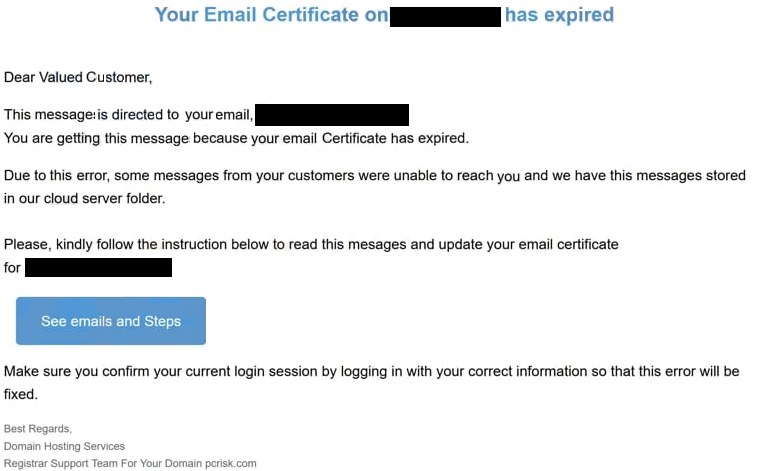Remove “Your Email Certificate Has Expired” phishing email
The “Your Email Certificate Has Expired” email falls into the phishing email category. It’s part of a phishing campaign that aims to trick users into revealing their email account login credentials. The email claims that the recipient’s email certificate has expired and needs to be renewed if they want to get the messages that have supposedly not been delivered because of this. Users who click on the button in the email and type their login credentials may have their accounts hijacked by malicious actors.
This “Your Email Certificate Has Expired” email is a pretty generic phishing email. If you receive it, you should be able to identify it as a phishing email immediately if you’re familiar with what such emails look like. Emails part of this phishing campaign explain that your email certificate has expired. The email asks that you renew your certificate because there are messages that have not been delivered to you because of this. Specifically, the email wants you to click on the provided button and follow the steps.
The full “Your Email Certificate Has Expired” phishing email contents are below:
Subject: ********: E-mail Certificate Expiration Notice
Your Email Certificate on ******** has expired
Dear Valued Customer,
This message is directed to your email, ********.
You are getting this message because your email Certificate has expired.Due to this error, some messages from your customers were unable to reach you and we have this messages stored in our cloud server folder.
Please, kindly follow the instruction below to read this mesages and update your email certificate for ********.
See emails and StepsMake sure you confirm your current login session by logging in with your correct information so that this error will be fixed.
If users click the “See emails and Steps” button, they will be redirected to a website that mimics a legitimate email service provider site. This site also displays a pop-up message stating that their session has expired and prompts them to log in again. If users enter their password, it is sent to the cybercriminals behind this phishing campaign. These criminals may either use the stolen credentials themselves or sell them to other malicious actors. Email login credentials are in high demand among cybercriminals because they contain sensitive information and are often connected to many other accounts. A hijacked account can grant malicious actors access to numerous other accounts.
How to recognize phishing emails?
Phishing campaigns that send the same email to many users are generally easy to spot because these emails tend to be vague and generic. They usually lack credible information and often contain several errors. In contrast, more sophisticated phishing emails are composed for specific individuals, using personal information that criminals have gathered. Such emails are significantly more convincing and may trick many users.
If you receive an unsolicited email requesting that you take action—such as clicking a link or opening an attachment—the first thing to do is verify the sender’s email address. You can search the email address on Google to see if it matches the person or organization it claims to represent. Sometimes, malicious email addresses may appear suspicious, making it easy to identify the phishing attempt. However, some attackers use tactics to make their addresses seem valid, such as replacing letters or adding extra characters. For example, they might insert an extra “f” to create an email address that looks similar to that of Netflix.
It’s also essential to notice grammar and spelling mistakes in these emails. Phishing emails often contain multiple mistakes. Although the “Your Email Certificate Has Expired” phishing email may not have much text, the awkward phrasing is pretty noticeable. Legitimate emails from service providers typically do not contain any mistakes.
Users should take their time to assess all emails before rushing to respond, particularly if the email urges them to click links or open attachments. Carefully considering the email’s context is essential. For instance, the “Your Email Certificate Has Expired” email is obviously fake when one considers that email providers do not send out such notifications.
Finally, it is a good idea to avoid clicking on links within these emails altogether. If there is an account issue requiring attention, users should navigate to the website directly by typing its URL into a web browser, rather than clicking a link. For instance, if users receive an email from Netflix about a failed payment, they should log into their account directly to address the issue instead of using the link from the email.
“Your Email Certificate Has Expired” phishing email removal
If you receive a phishing email that says “Your Email Certificate Has Expired,” simply delete it. If you have already interacted with the email and entered your email login credentials, it is important to change your password immediately, provided your account is still accessible. Additionally, review your account activity to check for any unauthorized logins.
If your email account has been compromised, the best course of action is to contact your email service provider to regain control of your account. It is also essential to disconnect your email address from all other accounts to prevent them from being hijacked as well.
Site Disclaimer
WiperSoft.com is not sponsored, affiliated, linked to or owned by malware developers or distributors that are referred to in this article. The article does NOT endorse or promote malicious programs. The intention behind it is to present useful information that will help users to detect and eliminate malware from their computer by using WiperSoft and/or the manual removal guide.
The article should only be used for educational purposes. If you follow the instructions provided in the article, you agree to be bound by this disclaimer. We do not guarantee that the article will aid you in completely removing the malware from your PC. Malicious programs are constantly developing, which is why it is not always easy or possible to clean the computer by using only the manual removal guide.

